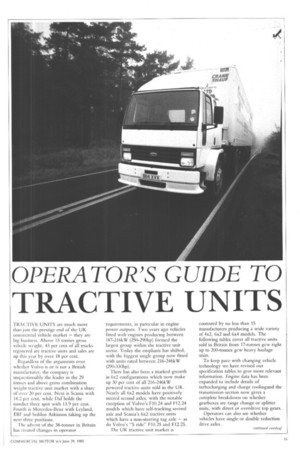OPERATOR'S GUIDE To
Page 57

If you've noticed an error in this article please click here to report it so we can fix it.
TRACTIVE UNITS
TRACTIVE UNITS are much more than just the prestige end of the UK commercial vehicle market — they are big business. Above 15 tonnes gross vehicle weight, 43 per cent of all trucks registered are tractive units and sales are up this year by over 18 per cent.
Regardless of the arguments over whether Volvo is or is not a British manufacturer, the company is unquestionably the leader in the 29 tonnes and above gross combination weight tractive unit market with a share of over 20 per cent. Next is Scania with 14.2 per cent, while Daf holds the number three spot with 13.9 per cent. Fourth is Mercedes-Benz with Leyland, ERF and Seddon Atkinson taking up the next three positions.
The advent of the 38-tonner in Britain has created changes in operator requirements, in particular in engine power outputs. Two years ago vehicles fitted with engines producing between 187-216kW (250-2901m) formed the largest group within the tractive unit sector. Today the emphasis has shifted, with the biggest single group now fitted with units rated between 216-246kW (290-330hp).
There has also been a marked growth in 6x2 configurations which now make up 30 per cent of all 216-246kW powered tractive units sold in the UK. Nearly all 6x2 models have positively steered second axles, with the notable exception of Volvo's F10.24 and F12.24 models which have self-tracking second axle and Scania's 6x2 tractive units which have a non-steering tag axle — as do Volvo's "S ride" F10.25 and F12.25.
The UK tiactive unit market is contested by no less than 15 manufacturers producing a wide variety of 4x2, 6x2 and 6x4 models. The following tables cover all tractive units sold in Britain from 17-tonnes gcw right up to 200-tonnes gcw heavy haulage units.
To keep pace with changing vehicle technology we have revised our specification tables to give more relevant information. Engine data has been expanded to include details of turbocharging and charge coolingand the transmission section now gives a complete breakdown on whether gearboxes are range change or splitter units, with direct or overdrive top gears.
Operators can also see whether vehicles have single or double reduction drive axles.




































































































